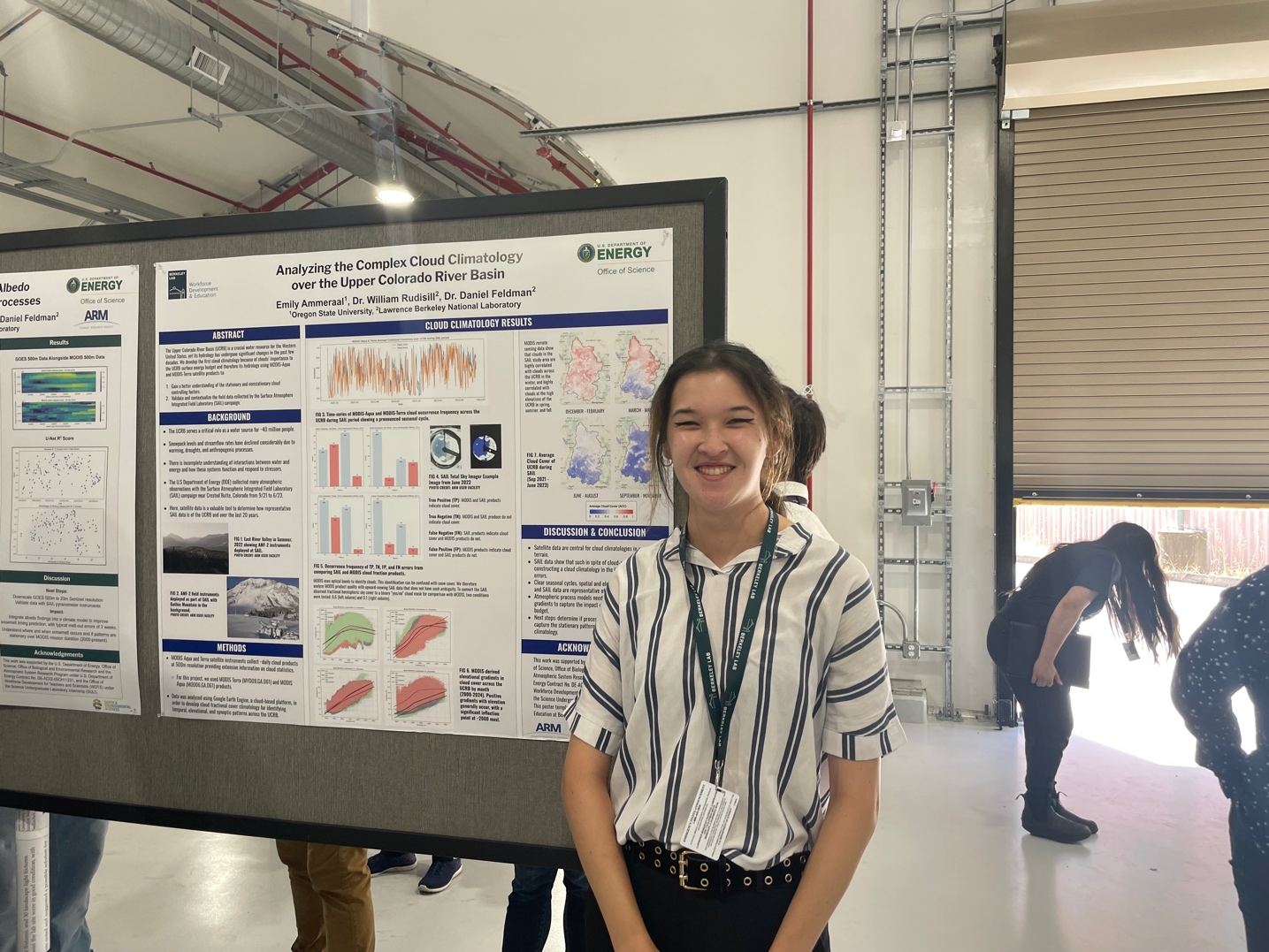Interns Chart New Directions With SAIL Data
Published: 24 September 2024
Editor’s note: Daniel Feldman, principal investigator for ARM’s Surface Atmosphere Integrated Field Laboratory (SAIL) campaign, and SAIL co-investigator Allison C. Aiken sent in this update. Feldman is at Lawrence Berkeley National Laboratory in California, and Aiken is at Los Alamos National Laboratory in New Mexico.
Lawrence Berkeley National Laboratory hosted two students in the summer of 2024 as part of DOE’s Science Undergraduate Laboratory Internships (SULI) program to lean into remote sensing support for SAIL data analysis.
Another student, who was matched for an internship at Los Alamos National Laboratory through Sustainable Horizons Institute’s Sustainable Research Pathways program and also supported by the SULI program, wrote new machine learning algorithms to analyze SAIL aerosol data.
Read about the interns’ experiences:
Emily Ammeraal, Oregon State University, SULI Intern

This summer, I had the pleasure of interning at Lawrence Berkeley National Laboratory, where I contributed to developing the first cloud climatology model for the Upper Colorado River Basin and validated SAIL data using MODIS (Moderate Resolution Imaging Spectroradiometer) satellite imagery. Under the mentorship of Dr. Daniel Feldman and Dr. William Rudisill, I gained valuable insights into the region’s hydrology and atmospheric dynamics, strengthening my modeling and data analysis skills.
Before this internship, I hadn’t been involved in scientific research, so gaining firsthand experience, collaborating with various researchers, and connecting with a group of amazing interns was incredibly meaningful.
I am grateful to have contributed to such unique and significant research, and I am excited to apply my newly honed skills and knowledge toward completing my graduate degree and future endeavors.
Check out Emily’s SULI report and poster, along with a video on her internship at Berkeley Lab.
Felix Yu, University of Michigan, SULI Intern

This summer, I worked at Lawrence Berkeley National Laboratory in the Earth and Environmental Sciences Area. My project was to analyze snow albedo data sets over the Colorado River using satellite data gathered over the SAIL campaign and machine learning techniques.
I really enjoyed my time collaborating with the researchers and other interns, who were all extremely knowledgeable and open to help me with my project. As a computer science major, it was great to learn more about the foundational environmental science concepts about snowmelt and snow albedo in order to do the computation necessary to complete my project. My mentors were instrumental to all the knowledge, skills, and connections I made throughout my time at the lab.
I hope to continue to build on these skills to complete an undergraduate thesis and further my studies through graduate school.
Check out Felix’s SULI report and poster, and see him discuss his internship.
While Felix and Emily have returned to school to complete their STEM degrees, their SAIL contributions continue: They are co-authors on SAIL-related submissions to the 2024 American Geophysical Union Annual Meeting, and they are submitting their data products to ARM Data Discovery to share the results with the larger scientific community.

Elijah Valverde, San Francisco State University, Sustainable Research Pathways and SULI Intern

During my internship at Los Alamos National Laboratory, I worked on exploring the applications of a Gaussian process to aerosol data sets gathered during the SAIL campaign. A Gaussian process is a type of machine learning model specified by its mean and covariance functions. It is particularly effective for uncertainty quantification as it provides a probability distribution over functions, allowing for a confidence interval to be calculated.
We applied the Gaussian process model to the aerosol data by specifying a periodic covariance function, providing a prior distribution that essentially “informed” our model that we believed the data had some periodic structure. Our goal was that the model, equipped with the periodic covariance function, would validate our beliefs about the data’s structure—in other words, that the model would perform well and learn a periodic structure in the data.
During my time working on this project, I had the opportunity of collaborating and learning from brilliant researchers across numerous disciplines. This was the most fun part of my research as I had the pleasure of being surrounded by so many people excited to share science. I also was able to learn so much about aerosols and environmental science as a whole, a topic I thought I would never research, but had such a great time doing so. In addition, I learned a lot regarding the process of research thanks to my mentors. It is because of my experience at Los Alamos I am now equipped to continue contributing to exciting and impactful research as an undergraduate and eventually use the tools and skills I learned to succeed in graduate school and beyond!
At the close of his internship, Elijah won an award for his poster presentation at the Los Alamos National Laboratory Student Symposium. View Elijah’s poster.
Apply now for DOE undergraduate internships: DOE is accepting SULI applications for the spring 2025 term. Community college students can also apply to DOE’s Community College Internships (CCI) program for spring 2025. The application deadline for both programs is October 2, 2024, at 5 p.m. Eastern time. Get more information.
Keep up with the Atmospheric Observer
Updates on ARM news, events, and opportunities delivered to your inbox
ARM User Profile
ARM welcomes users from all institutions and nations. A free ARM user account is needed to access ARM data.


















